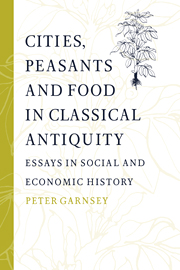Book contents
- Frontmatter
- Contents
- Preface
- Editor's preface
- Acknowledgements
- List of abbreviations
- PART I CITIES
- PART II PEASANTS
- 6 Peasants in ancient Roman society
- 7 Where did Italian peasants live?
- 8 Non-slave labour in the Roman world
- 9 Prolegomenon to a study of the land in the later Roman empire
- 10 Mountain economies in southern Europe
- PART III FOOD
- Bibliography
- Index
7 - Where did Italian peasants live?
Published online by Cambridge University Press: 02 December 2009
- Frontmatter
- Contents
- Preface
- Editor's preface
- Acknowledgements
- List of abbreviations
- PART I CITIES
- PART II PEASANTS
- 6 Peasants in ancient Roman society
- 7 Where did Italian peasants live?
- 8 Non-slave labour in the Roman world
- 9 Prolegomenon to a study of the land in the later Roman empire
- 10 Mountain economies in southern Europe
- PART III FOOD
- Bibliography
- Index
Summary
Until recently this was a question that was not asked. It was not asked because there was a prior question that was asked, and that received a negative answer: Did peasant proprietors survive in significant numbers in the late Republic or early Empire?
The consensus of opinion has been that they were always to be found, but that they were relatively few. As the traditional rural economy of which they had been the characteristic feature gave way under the impact of new economic forces, they became a residual phenomenon. Moreover, this development had already occurred by the late second century BC.
It is to be noted that peasant proprietors, small farmers working the land they owned, rather than free cultivators as a whole, have usually been the object of inquiry. The roles of tenancy in the late Republic and of wage labour in all periods have rarely been positively evaluated. Again, the idea that small owner-cultivators, tenant-farmers and day-labourers were overlapping categories in ancient Italy has been little developed in the scholarly literature.
The literary sources for Roman agrarian history are largely responsible for these prevailing attitudes. They have long monopolized the attention of ancient historians, despite their more or less obvious inadequacies. The supposed rout of the free peasantry in the second century BC is grounded in the accounts of the Gracchan crisis of Appian and Plutarch and the even briefer generalizations of Sallust.
- Type
- Chapter
- Information
- Cities, Peasants and Food in Classical AntiquityEssays in Social and Economic History, pp. 107 - 133Publisher: Cambridge University PressPrint publication year: 1998



